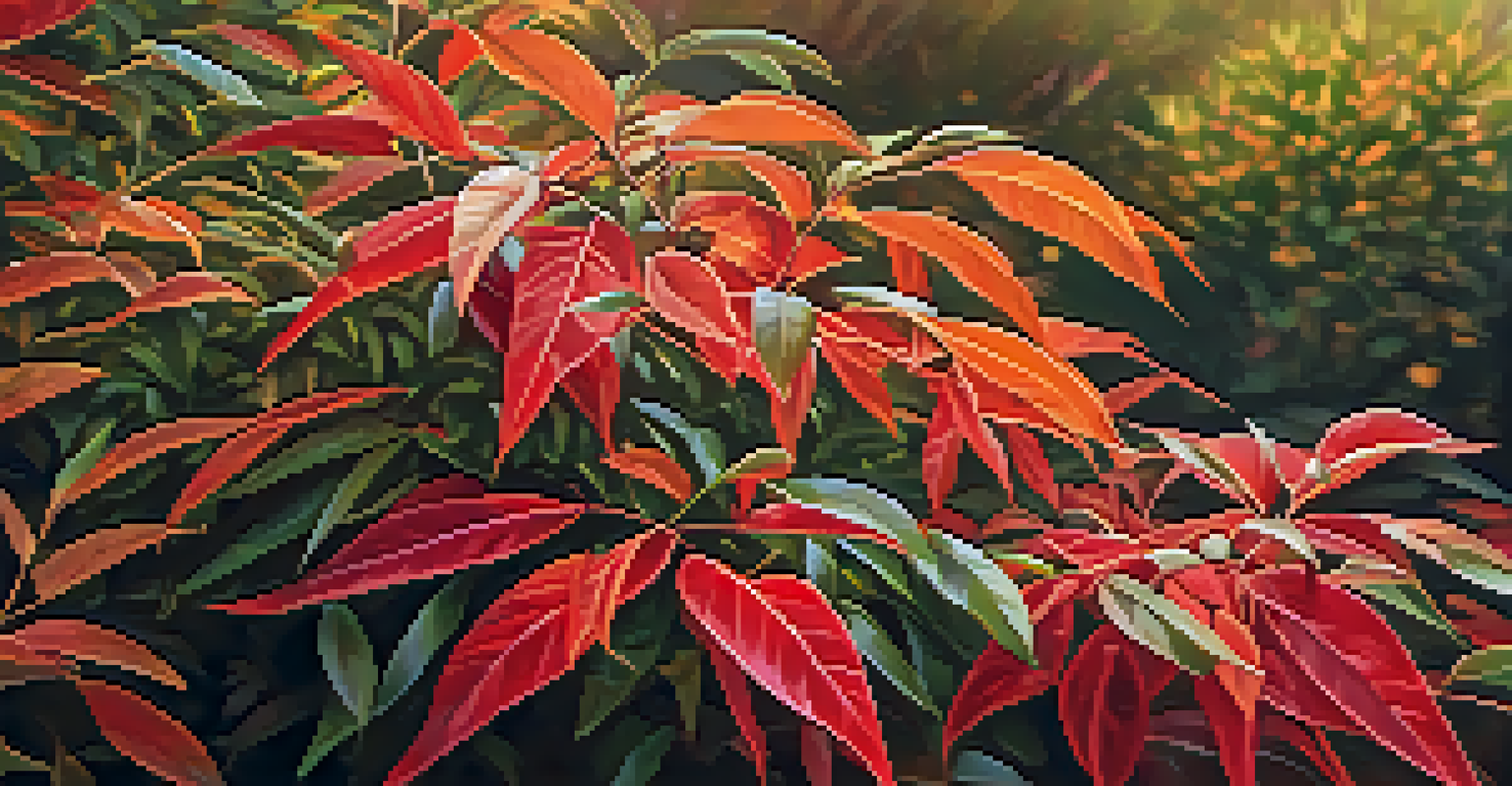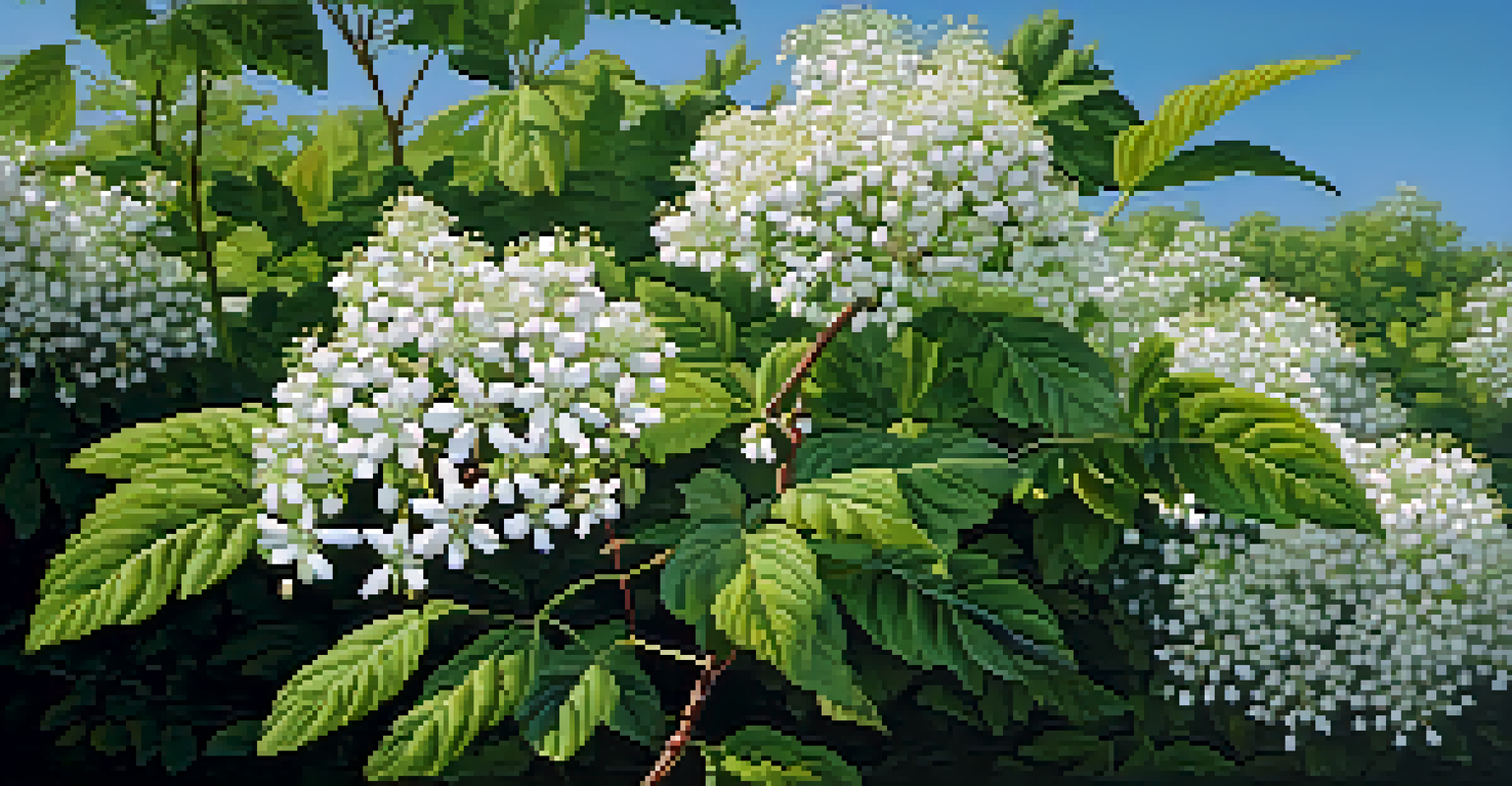10 Essential Shrubs for a Climate-Resilient Garden

Understanding Climate-Resilient Gardening Basics
Climate-resilient gardening focuses on selecting plants that can withstand extreme weather and changing environmental conditions. By incorporating native and drought-tolerant species, you can create a garden that remains vibrant despite climate challenges. This approach not only conserves water but also supports local wildlife and promotes biodiversity.
The greatest threat to our planet is the belief that someone else will save it.
The key is to choose plants that are well-adapted to your local climate and soil types. This means understanding your region's specific conditions, such as rainfall patterns, temperature fluctuations, and soil composition. A climate-resilient garden can be both beautiful and functional, providing a sustainable habitat for various species.
For this journey, we’ll explore ten essential shrubs that can help you build a robust and resilient garden. Each of these shrubs has unique attributes that make them suited for a variety of climates, helping you to create an outdoor space that thrives year-round.
1. Butterfly Bush: A Nectar Magnet
The Butterfly Bush, or Buddleia, is a favorite among pollinators, attracting butterflies and hummingbirds with its fragrant flowers. This hardy shrub can tolerate drought once established, making it a great choice for gardens in drier climates. Its vibrant blooms come in various colors, adding a pop of beauty to your landscape.

In addition to its aesthetic appeal, the Butterfly Bush is low-maintenance, requiring minimal pruning and care. It thrives in sunny spots and well-drained soil, making it adaptable to different garden settings. By planting this shrub, you’ll not only enhance your garden’s beauty but also support local ecosystems.
Choose Resilient Plants
Selecting native and drought-tolerant shrubs helps create a garden that thrives in changing climates.
Keep in mind that while it’s loved by pollinators, the Butterfly Bush can be invasive in some areas. It’s important to check local guidelines and consider planting non-invasive varieties or controlling its spread to maintain a balanced garden.
2. Boxwood: Timeless Greenery
Boxwood shrubs are classic hedges known for their dense foliage and versatility. They can be easily shaped into various forms, making them a popular choice for formal gardens and landscape designs. Beyond their aesthetic value, Boxwoods are resilient and can thrive in a range of climates, including both cold winters and hot summers.
Nature does not hurry, yet everything is accomplished.
These shrubs prefer well-drained soil and partial shade but can adapt to full sun conditions as well. Their evergreen nature means they provide year-round greenery, which can be a comforting sight during the colder months. Plus, once established, Boxwoods require minimal watering, making them a practical choice for sustainable gardening.
However, be mindful of common pests such as boxwood leaf miners, which can affect their health. Regular monitoring and care can help keep your Boxwoods thriving, ensuring they remain a staple in your climate-resilient garden.
3. Hydrangea: Colorful Blooms for All Seasons
Hydrangeas are loved for their stunning blooms and ability to adapt to different soil types and moisture levels. These shrubs flourish in a variety of conditions, from sunny spots to shady corners, making them a versatile choice for your garden. Their flowers change color based on soil pH, adding an element of surprise to your landscape.
These plants are relatively low-maintenance and can withstand periods of drought once established, although they thrive with consistent moisture. Their ability to bounce back after harsh weather makes them a resilient option for changing climates. By choosing hydrangeas, you can enjoy a dynamic display of color throughout the growing season.
Support Local Ecosystems
Incorporating climate-resilient plants not only enhances garden beauty but also promotes biodiversity and supports wildlife.
When planting hydrangeas, it's important to select the right variety for your region, as some are more tolerant of heat and drought than others. With proper care, these shrubs can become a striking focal point in your climate-resilient garden.
4. Juniper: Tough and Low-Maintenance
Juniper shrubs are incredibly resilient, thriving in poor soils and requiring minimal water once established. Their evergreen foliage adds year-round interest to your garden, while their drought tolerance makes them an excellent choice for climate-resilient landscaping. With various species available, you can find junipers that fit any garden style, from low ground covers to upright specimens.
These hardy shrubs are also resistant to many pests and diseases, making them a low-maintenance option for busy gardeners. They can handle full sun to partial shade, providing flexibility in planting locations. Plus, their ability to withstand wind and drought makes them ideal for challenging climates.
If you're looking to create a low-maintenance garden, junipers can serve as a reliable backbone. Their ruggedness and adaptability ensure they’ll thrive even in the face of environmental stresses.
5. Spirea: A Blooming Beauty
Spirea shrubs are celebrated for their abundant flowers and easy care, making them a popular choice for gardeners of all levels. These deciduous shrubs produce clusters of blooms in spring and summer, attracting butterflies and beneficial insects. Their adaptability to a range of soil types and climates makes them a resilient addition to any garden.
Spireas prefer full sun but can tolerate some shade, and they thrive with minimal watering once established. They also offer beautiful fall foliage, adding seasonal interest to your landscape. With various types available, you can choose spireas that fit your aesthetic and maintenance preferences.
Consider Local Conditions
Understanding your local climate and soil types is crucial for choosing the right shrubs for a sustainable garden.
Regular pruning helps promote new growth and maintain their shape, but overall, they require little attention. By incorporating spirea into your garden, you’ll enjoy a vibrant display of color while supporting local wildlife.
6. Nandina: A Colorful Evergreen
Nandina, often called heavenly bamboo, is a stunning evergreen shrub that brings color and texture to any garden. Its feathery leaves turn vibrant shades of red and orange in the fall, providing visual interest throughout the seasons. This shrub is also drought-tolerant once established, making it suitable for various climates.
Nandina thrives in well-drained soil and can adapt to both sun and shade, allowing for versatile planting options. It grows well in a variety of settings, from borders to mixed shrub beds, enhancing your landscape's overall appeal. Additionally, it produces small white flowers in spring, followed by bright red berries that attract birds.

While nandina is beautiful, it's important to note that some varieties can be invasive in certain areas. Always check local guidelines and consider planting non-invasive options to maintain a balanced garden.
7. Elderberry: A Fruitful Addition
Elderberry shrubs are not only beautiful with their lacy flowers, but they also produce delicious and nutritious berries. These hardy shrubs thrive in a range of soil types and can tolerate wet conditions, making them a valuable addition to a climate-resilient garden. Elderberries are also a favorite among birds and pollinators, promoting biodiversity in your outdoor space.
They prefer full sun for optimal berry production but can tolerate partial shade. These shrubs require minimal maintenance and can be pruned to control their size and shape. Plus, their berries can be used to make syrups and jams, adding an edible element to your landscape.
When planting elderberries, be sure to include both male and female plants for better fruiting. With their striking flowers and tasty berries, elderberries can enhance both the beauty and functionality of your garden.
8. Conclusion: Building Your Resilient Garden
Creating a climate-resilient garden is all about making smart plant choices that thrive in changing conditions. The shrubs discussed in this article offer a diverse range of options, from vibrant blooms to hardy evergreens, each contributing to a sustainable landscape. By selecting the right plants, you can create a garden that not only survives but flourishes.
Remember to consider your local climate and soil conditions when planning your garden, as this will help you choose shrubs that are best suited for your area. Additionally, incorporating a mix of native and drought-tolerant species will enhance your garden’s resilience and support local wildlife.
As you embark on your gardening journey, keep these essential shrubs in mind. With a little care and the right choices, you can cultivate a beautiful, thriving garden that withstands the test of time and climate challenges.